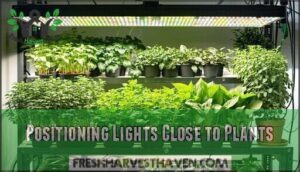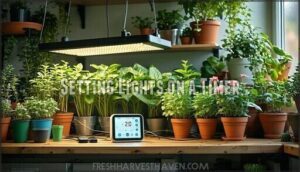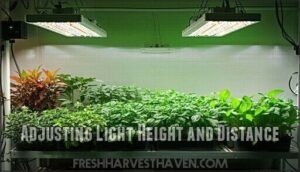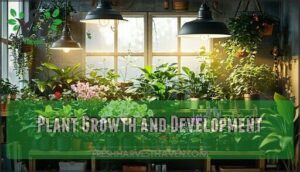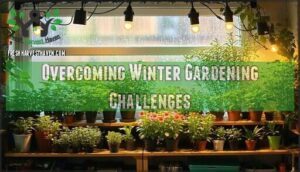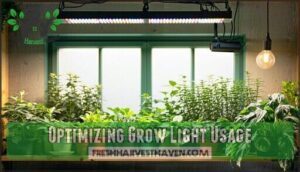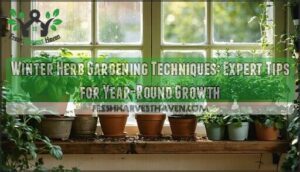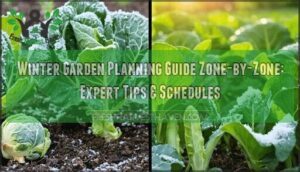This site is supported by our readers. We may earn a commission, at no cost to you, if you purchase through links.
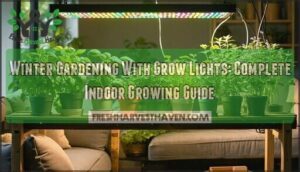 Winter gardening with grow lights transforms your home into a year-round growing sanctuary.
Winter gardening with grow lights transforms your home into a year-round growing sanctuary.
You’ll need full-spectrum LED or fluorescent lights positioned 6-12 inches above your plants, providing 12-16 hours of daily illumination.
Herbs like basil, oregano, and thyme thrive under artificial lighting, while leafy greens and microgreens flourish with proper photosynthetic support.
Position lights on timers to maintain consistent photoperiods, mimicking natural daylight cycles your plants crave.
Temperature control remains essential—most indoor crops prefer 65-75°F for ideal growth.
Master the balance between light intensity, duration, and plant spacing to maximize yields, as the secret lies in understanding each plant’s unique lighting requirements.
Table Of Contents
- Key Takeaways
- Winter Gardening Basics
- Choosing Grow Lights
- Setting Up Grow Lights
- Plant Growth and Development
- Overcoming Winter Gardening Challenges
- Optimizing Grow Light Usage
- Frequently Asked Questions (FAQs)
- Should you use grow lights in winter?
- When should I stop using grow lights?
- How to give plants light in winter?
- Will grow lights keep plants from freezing?
- Should I use a grow light for my plants in the winter?
- What color grows light for winter?
- What lights are best for indoor plants in winter?
- Do plants need less light in winter?
- How to give plants sunlight in winter?
- How do grow lights affect plant dormancy?
- Conclusion
Key Takeaways
- You’ll need full-spectrum LED grow lights positioned 6-12 inches above your plants, running 12-16 hours daily to replace winter’s weak sunlight and maintain healthy photosynthesis.
- Your plants require specific light intensities—seedlings need lights 2-3 inches away, while mature houseplants thrive with fixtures 12-18 inches above to prevent light burn and ensure proper growth.
- You can successfully grow herbs like basil and oregano, leafy greens, and microgreens indoors year-round by maintaining consistent 65-75°F temperatures alongside proper lighting schedules.
- You’ll maximize results by using timers for automated light cycles, monitoring plants for signs of overexposure (bleached leaves) or underexposure (leggy growth), and adjusting light height as plants mature.
Winter Gardening Basics
When winter’s shortened daylight hours limit your plants’ access to natural sunlight, you’ll need to understand how artificial lighting systems can replicate the photosynthetically active radiation (PAR) that drives essential plant processes.
Your indoor garden’s success depends on providing the right light spectrum, intensity levels of 50-100 µmol/m²/s, and consistent photoperiods that support photosynthesis and healthy growth throughout the dormant season.
Your plants crave the perfect light recipe—spectrum, intensity, and timing—to thrive when winter steals their sunshine.
Plant Lighting Requirements
Understanding your plants’ lighting needs transforms winter indoor gardening from guesswork into science.
During shorter days, your green companions desperately need artificial illumination to fuel the photosynthesis process and maintain robust plant metabolism.
Think of grow lights as nutritional supplements for your leafy friends.
Think of grow lights as your plants’ personal winter sunshine, delivering exactly the energy they crave when nature falls short.
Without proper light spectrum exposure, plants become weak, stretched, and pale—classic signs of light starvation that every indoor gardener dreads.
Essential lighting requirements include:
- Light intensity: 500-700 µmol/m²/s PPFD for ideal photosynthesis
- Daily exposure: 8-10 hours minimum for most indoor plants
- Spectrum balance: Full-spectrum LED grow lights (5000-6500K) mimicking natural sunlight
LED grow lights excel at delivering precise light spectrum combinations.
Blue wavelengths (450nm) promote vegetative growth, while red wavelengths (660nm) trigger flowering.
Consistent lighting cycles regulate your plants’ biological clocks, preventing dormancy and maintaining year-round plant growth.
Quality grow light types include detailed spectrum charts, ensuring your indoor gardening setup delivers exactly what your plants crave.
Effective grow light strategies are vital for ideal winter plant growth and development.
Grow Light Design Advantages
Modern grow light systems have transformed indoor gardening through superior engineering.
LED Efficiency means you’ll slash energy costs while delivering ideal Spectrum Control for plant development.
These grow light systems feature advanced Light Distribution technology that eliminates dark spots and hot zones.
Unlike outdated fluorescent bulbs, today’s LED grow lights offer remarkable Energy Savings—up to 75% less electricity consumption.
Durability Factors include 50,000+ hour lifespans and heat-resistant components.
You’re getting precise light spectrum control with adjustable wavelengths, making indoor gardening both economical and scientifically precise.
Types of Plants Grown Under Grow Lights
Understanding your grow light’s capabilities opens up endless possibilities for winter plants and indoor gardening.
You’ll discover that nearly every plant category responds well to artificial lighting when positioned correctly.
Grow lights transform your home into a productive winter sanctuary:
- Leafy greens like spinach and arugula produce fresh harvests continuously
- Herb gardens featuring basil, oregano, and thyme thrive under LED systems
- Flowering plants such as African violets bloom magnificently with proper spectrum lighting
- Microgreens sprout rapidly, providing nutrient-dense additions to meals
- Succulents maintain vibrant colors and compact growth patterns year-round
Choosing Grow Lights
Your winter indoor gardening success hinges on smart bulb selection that matches your plants’ needs.
LED Options dominate today’s market, offering superior light efficiency compared to traditional fluorescent or incandescent alternatives.
When evaluating grow light types, prioritize these features:
- Full-spectrum LEDs (400-700nm) that replicate natural sunlight for ideal photosynthesis
- Energy-efficient designs like 24W chips that keep electricity costs manageable
- Aluminum housing for effective heat dissipation and plant protection.
Spectrum analysis reveals that quality LED grow lights provide the perfect balance for thriving indoor gardening year-round.
Understanding cold hardy plants is also vital for a successful winter garden, whether indoors or outdoors.
Setting Up Grow Lights
You’ll need to position your grow lights 6-12 inches above your plants and set them on a timer to provide 12-16 hours of consistent light daily for ideal photosynthesis.
Proper setup requires adjusting the light height as your plants grow, maintaining the correct distance to prevent light burn while ensuring adequate light intensity reaches all foliage.
Positioning Lights Close to Plants
Finding the sweet spot for light placement determines your indoor garden’s success.
Position your grow light fixtures 6-12 inches from vegetables and herbs, while mature houseplants thrive with lights positioned 12-18 inches away.
Light distance directly affects light intensity – too close causes leaf burn and heat stress, while excessive distance creates leggy, stretched growth.
Monitor plant height regularly and adjust light height accordingly.
Watch for warning signs: bleached leaves signal overexposure, while spindly stems indicate insufficient light proximity.
Positioning lights properly in your grow space guarantees maximal photosynthesis without damaging delicate foliage through effective shade management.
To achieve maximal growth, consider implementing indoor herb techniques in your winter gardening setup.
Setting Lights on a Timer
Through proper Timer Settings, you’ll establish consistent Light Cycles that support healthy plant growth.
Most indoor plants require 12-16 hours of Daily Scheduling using Automated Lighting systems. This Photoperiod Control mimics natural daylight patterns while reducing energy costs.
Essential light timer usage considerations include:
- Set light duration guidelines between 12-16 hours for ideal photosynthesis
- Program consistent on/off times to establish reliable lighting schedule patterns
- Choose digital timers with multiple daily cycles for precise light schedule control
- Monitor plant responses and adjust light cycles based on growth stages
- Use backup power sources to maintain uninterrupted photoperiod during outages
For optimal growth, understanding grow light timers is vital for indoor gardening success.
Adjusting Light Height and Distance
Getting your light placement dialed in determines whether your plants thrive or simply survive. Distance control isn’t guesswork—it’s science that directly affects light intensity and plant health.
Proper height adjustment creates optimal growing conditions:
- Seedling stage: Position grow light fixtures 24-36 inches above to prevent shock
- Vegetative growth: Maintain 12-24 inches for maximum light positioning efficiency
- Flowering phase: Adjust to 12-18 inches while monitoring beam focus
Smart photoperiod management means adjusting light distance as plants grow, ensuring consistent light height for balanced development. Understanding essential light spacing is vital for healthy plant growth and maximizing yields.
Plant Growth and Development
Understanding plant growth and development under artificial lighting requires careful attention to light spectrum, intensity, and environmental conditions that drive photosynthesis and cellular processes.
You’ll need to balance these factors with proper temperature control to create ideal growing conditions that support healthy plant metabolism throughout the winter months, ensuring healthy plant growth.
Importance of Light Spectrum and Color
Why does your plant’s winter growth depend so heavily on getting the right light spectrum? Think of light color as your plant’s dietary menu—each wavelength serves a specific nutritional purpose that directly impacts growth and development.
Light Spectrum fundamentals reveal how different wavelengths trigger distinct plant responses. Blue Wavelength (400-500nm) promotes compact, leafy growth by encouraging chlorophyll production and preventing leggy stems. Red Light (600-700nm) stimulates flowering and fruiting processes, making it essential for reproductive stages.
| Light Type | Wavelength Range | Primary Function |
|---|---|---|
| Blue | 400-500nm | Vegetative growth, compact structure |
| Red | 600-700nm | Flowering, fruiting, elongation |
| Green | 500-600nm | Minimal photosynthesis impact |
| Full Spectrum | 400-700nm | Complete growth support |
Understanding sunlight requirements is vital for optimizing plant growth. LED grow lights with proper Color Temperature (5000-6500K) provide balanced fullspectrum lighting that mimics natural sunlight, optimizing photosynthesis throughout winter months.
Light Intensity and Plant Placement
Beyond spectrum considerations, light intensity determines your grow room’s success.
Position LED grow lights 6-12 inches from sun-loving vegetables, while shade-tolerant houseplants thrive at 12-18 inches.
Light distance directly affects energy absorption—too close scorches leaves, too far creates leggy growth.
Strategic plant spacing prevents shadows between specimens.
Adjust light angles as plants mature, maintaining proper intensity levels of 150-300 µmol/m²/s.
Proper shade management guarantees uniform coverage across your entire growing area.
Balancing Light and Temperature
Winter gardening success hinges on light balance and temperature control working together like dance partners.
Your grow lights generate heat that can stress plants if temperatures exceed 75°F, while insufficient warmth below 65°F slows growth. Photoperiod management requires monitoring both factors simultaneously for ideal climate regulation.
Here’s your spectrum optimization checklist:
- Position grow lights 6-12 inches from plant canopy
- Maintain 65-75°F ambient temperature during light intensity periods
- Use fans for air circulation when heat builds up
- Monitor leaf edges for heat stress signs
- Adjust winter gardening tips based on plant response
Overcoming Winter Gardening Challenges
Winter gardening presents specific physiological challenges that can disrupt your plants’ metabolic processes, including light deprivation, photosynthetic stress, and temperature fluctuations that affect cellular function.
You’ll need to recognize these symptoms early and implement targeted solutions to maintain ideal growing conditions throughout the dormant season.
Light Deprivation and Solutions
Sometimes your plants’ tired, leggy look signals they’re struggling with light deprivation. This happens when shorter winter days rob them of the 10-12 hours of light essential for photosynthesis.
Symptoms like yellowing leaves, stunted growth, and weak roots are common when plants can’t get enough light to thrive.
That’s where supplemental lighting steps in, offering a lifesaver for indoor winter gardening. Switching to grow light therapy guarantees your plants receive the necessary energy boost they need.
Choose full-spectrum grow lights to mimic natural sunlight, supporting processes like photosynthesis and warding off premature plant dormancy.
Give plants their glow-up by keeping light cycles steady (12-16 hours daily). Don’t let winter steal your plants’ spark—restore balance and trigger a vibrant winter bloom indoors!
Overexposure to Light and Remedies
Too much light creates plant stress just like too little.
Overexposure manifests as light burn – bleached leaves, crispy edges, and stunted growth that screams "help me!"
Remedies found through damage control include increasing distance between fixtures and foliage, dimming intensity settings, or adding sheer barriers.
Light reduction and light intensity adjustments reverse photo damage quickly.
Most plants bounce back once you’ve dialed down their light therapy regimen.
Temperature Fluctuations and Control
Most indoor gardeners underestimate how temperature fluctuations sabotage plant health. Your plants need consistent temperatures between 65-75°F during daylight hours and never below 50°F at night—thermal control isn’t optional.
LED grow lights excel at heat management compared to traditional HPS systems, but proper positioning remains vital. Install temperature sensors throughout your growing area and connect them to a reliable thermostat controller for automated climate regulation.
Essential temperature monitoring strategies include:
- Position sensors at plant canopy level for accurate readings
- Use cooling systems like exhaust fans during peak heat periods
- Maintain consistent air circulation to prevent hot spots
- Set thermostats with 2-3°F buffer zones to minimize cycling
- Monitor nighttime temperatures to prevent metabolic slowdown
Optimizing Grow Light Usage
You’ve mastered the basics of grow light setup, but fine-tuning your system transforms average results into thriving indoor gardens that rival outdoor growth.
Strategic positioning, proper timing, and spectrum selection create ideal photosynthetic conditions that maximize plant development.
While preventing common issues like light burn or energy waste is crucial, it is part of the overall goal to achieve thriving indoor gardens.
Maximizing Seedling Development
Starting seedlings indoors transforms your winter gardening game completely.
Position LED grow lights 2-3 inches above emerging seedlings, preventing that dreaded leggy stretch.
Blue spectrum wavelengths fuel robust vegetative growth while proper soil quality and water management create ideal conditions.
| Growth Stage | Light Distance | Daily Duration | Key Focus |
|---|---|---|---|
| Germination | 3-4 inches | 12-14 hours | Gentle warmth |
| Early Growth | 2-3 inches | 14-16 hours | Blue spectrum |
| Pre-transplant | 4-6 inches | 16 hours | Full spectrum |
| Hardening Off | 6-8 inches | Natural cycle | Gradual shift |
Gradually increase light duration to 16 hours daily for seedling development success.
This approach ensures proper soil quality and water management are maintained, creating an ideal environment for growth.
Enhancing Houseplants With Grow Lights
Beyond nurturing seedlings, your mature houseplants deserve the same LED grow lights attention during winter’s harsh months.
Position LED grow lights 12-18 inches above tall plants, rotating them weekly for uniform development. Set timers for 12-14 hours daily to support tropical varieties, while adding humidity trays creates ideal growing conditions.
Group plants by similar light requirements to maximize efficiency and simplify your indoor gardening routine. Utilizing proper indoor herb garden techniques can also enhance your houseplant care.
Transform your houseplant care with these LED benefits:
- Watch drooping leaves perk up within days of proper plant lighting
- Experience the satisfaction of lush, vibrant foliage year-round
- Create a living sanctuary that lifts your winter spirits
- Enjoy healthier air quality from thriving plants
- Feel proud showing off your flourishing indoor garden to guests, which can be a great way to enjoy healthier air quality and have a living sanctuary that boosts your mood with lush, vibrant foliage and proper plant lighting.
Growing Herbs and Microgreens With Grow Lights
Several herbs and microgreens thrive under LED grow lights during winter’s darkest months.
Position your indoor gardening setup 6-8 inches below light panels, providing 14-16 hours of full-spectrum illumination daily.
Microgreen growth accelerates with proper herb lighting, while basil, cilantro, and sunflower shoots flourish under consistent grow light spectrum conditions.
This indoor farming approach transforms seed starting into year-round harvests.
Understanding the benefits of LED grow systems is essential for optimizing plant growth and health.
Frequently Asked Questions (FAQs)
Should you use grow lights in winter?
You’ll definitely need grow lights during winter months when natural sunlight drops below ideal levels.
They’re essential for maintaining photosynthesis, preventing leggy growth, and keeping your indoor plants healthy through shortened daylight periods.
When should I stop using grow lights?
You’re basically running a plant spa that never closes.
Stop using grow lights when natural daylight exceeds 12-14 hours daily, typically mid-to-late March.
Monitor your plants for adequate photosynthesis and healthy growth patterns.
How to give plants light in winter?
You’ll need full-spectrum LED grow lights positioned 6-12 inches above your plants.
Run them 12-16 hours daily using a timer.
This mimics natural sunlight and prevents winter’s light deprivation from stunting growth.
Will grow lights keep plants from freezing?
Grow lights won’t prevent freezing since they produce minimal heat.
You’ll need proper insulation and heating systems to protect plants from cold temperatures.
Lights support growth but can’t substitute for adequate thermal protection.
Should I use a grow light for my plants in the winter?
Yes, you should use grow lights for winter plants. They’ll compensate for shorter daylight hours, prevent leggy growth, and maintain healthy photosynthesis when natural sunlight drops below ideal levels.
What color grows light for winter?
Full-spectrum LED lights (5000-6500K) work best for winter indoor gardening.
You’ll want cool white light that mimics natural sunlight, providing balanced blue and red wavelengths for healthy vegetative growth and flowering.
What lights are best for indoor plants in winter?
Full-spectrum LED lights with 5000-6500K color temperature work best for indoor plants during winter.
They’ll provide balanced blue and red wavelengths your plants crave, mimicking natural sunlight while staying energy-efficient and cool-running, with a color temperature that supports plant growth.
Do plants need less light in winter?
Indoor plants actually require more supplemental lighting during winter months. You’ll need to compensate for shorter daylight hours and weaker sunlight intensity by providing 12-16 hours of artificial light daily.
How to give plants sunlight in winter?
You’ll need artificial lighting to replace winter’s weak sunlight.
Position full-spectrum LED grow lights 6-12 inches above your plants, running them 12-16 hours daily to maintain proper photosynthesis and healthy growth.
How do grow lights affect plant dormancy?
Grow lights interrupt natural dormancy cycles by extending photoperiods beyond seasonal norms.
You’ll need to adjust light duration and intensity strategically, allowing plants their necessary rest periods for healthy metabolism and proper seasonal phases.
Conclusion
Mastering winter gardening with grow lights means you’ll maintain thriving plants throughout the coldest months.
Your carefully calibrated lighting system, proper positioning, and consistent photoperiods create ideal growing conditions that rival summer’s natural sunlight.
Remember that successful indoor cultivation requires balancing light intensity, duration, and temperature control.
With proper setup and monitoring, you’ll harvest fresh herbs, microgreens, and leafy vegetables year-round.
Winter gardening with grow lights transforms your home into a productive, sustainable growing environment regardless of outdoor conditions.
- https://pmc.ncbi.nlm.nih.gov/articles/PMC8621602/
- https://www.quictents.com/blogs/gardening/mastering-grow-lights-to-indoor-winter-gardening
- https://pubs.acs.org/doi/10.1021/acsagscitech.1c00241
- https://blackbirdnews.com/the-science-behind-grow-lights-why-theyre-essential-for-winter-plant-care/
- https://www.mars-hydro.com/info/post/indoor-plants-growing-guide-in-winter-for-advanced-growers

